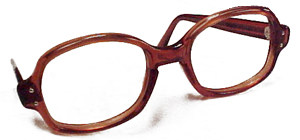GI glasses
GI glasses are a type of eyeglasses issued by the United States military to its service members. Dating back to World War II, these glasses have been a standard issue item, designed to be durable, functional, and inexpensive to manufacture. The term "GI" stands for "Government Issue" or "General Issue," reflecting the standard-issue nature of the equipment to military personnel.
Design and Features[edit | edit source]
The design of GI glasses has evolved over the years, but the focus has always been on durability and practicality. Early versions were often made with a thick, brown plastic frame, earning them the nickname "birth control glasses" due to their perceived unattractiveness. Despite their lack of style, these glasses were highly functional, designed to withstand the rigors of military life.
Modern iterations of GI glasses have seen improvements in both materials and design, with a focus on lighter weight materials and more contemporary styles. However, the primary criteria remain durability and cost-effectiveness. The current standard-issue model is known as the 5A, featuring a more stylish, rectangular frame that is significantly more appealing than its predecessors.
Issuance and Use[edit | edit source]
GI glasses are issued to service members during their initial entry training, following a comprehensive eye examination. If prescription eyewear is required, the military provides these glasses free of charge to the service member. The purpose is to ensure that all military personnel have access to high-quality vision correction, enabling them to perform their duties effectively.
In addition to the standard-issue glasses, service members may also receive inserts for gas masks and ballistic eyewear, ensuring that their vision correction needs are met in various operational environments.
Cultural Impact[edit | edit source]
While originally designed for functionality rather than fashion, GI glasses have made a unique impact on culture both within and outside the military. In the military, wearing GI glasses can be a rite of passage, symbolizing the transition from civilian to service member. Outside the military, these glasses have occasionally become a fashion statement, with vintage and retro styles gaining popularity in mainstream culture.
Future Developments[edit | edit source]
The military continues to research and develop new eyewear technologies to improve the performance and comfort of GI glasses. Innovations such as lighter weight materials, anti-reflective coatings, and UV protection are being explored to enhance the functionality of these glasses for service members.
Conclusion[edit | edit source]
GI glasses represent a blend of practicality, durability, and history. While their primary purpose is to provide vision correction for military personnel, their impact extends beyond their functional use, touching on aspects of military culture and fashion. As the military evolves, so too will the design and features of GI glasses, ensuring they continue to meet the needs of service members in the years to come.
Search WikiMD
Ad.Tired of being Overweight? Try W8MD's physician weight loss program.
Semaglutide (Ozempic / Wegovy and Tirzepatide (Mounjaro / Zepbound) available.
Advertise on WikiMD
|
WikiMD's Wellness Encyclopedia |
| Let Food Be Thy Medicine Medicine Thy Food - Hippocrates |
Translate this page: - East Asian
中文,
日本,
한국어,
South Asian
हिन्दी,
தமிழ்,
తెలుగు,
Urdu,
ಕನ್ನಡ,
Southeast Asian
Indonesian,
Vietnamese,
Thai,
မြန်မာဘာသာ,
বাংলা
European
español,
Deutsch,
français,
Greek,
português do Brasil,
polski,
română,
русский,
Nederlands,
norsk,
svenska,
suomi,
Italian
Middle Eastern & African
عربى,
Turkish,
Persian,
Hebrew,
Afrikaans,
isiZulu,
Kiswahili,
Other
Bulgarian,
Hungarian,
Czech,
Swedish,
മലയാളം,
मराठी,
ਪੰਜਾਬੀ,
ગુજરાતી,
Portuguese,
Ukrainian
Medical Disclaimer: WikiMD is not a substitute for professional medical advice. The information on WikiMD is provided as an information resource only, may be incorrect, outdated or misleading, and is not to be used or relied on for any diagnostic or treatment purposes. Please consult your health care provider before making any healthcare decisions or for guidance about a specific medical condition. WikiMD expressly disclaims responsibility, and shall have no liability, for any damages, loss, injury, or liability whatsoever suffered as a result of your reliance on the information contained in this site. By visiting this site you agree to the foregoing terms and conditions, which may from time to time be changed or supplemented by WikiMD. If you do not agree to the foregoing terms and conditions, you should not enter or use this site. See full disclaimer.
Credits:Most images are courtesy of Wikimedia commons, and templates, categories Wikipedia, licensed under CC BY SA or similar.
Contributors: Prab R. Tumpati, MD





